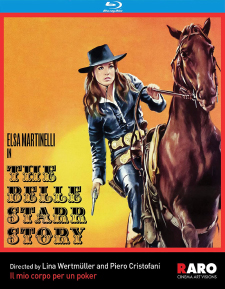Belle Starr Story, The (Blu-ray Review)

Director
Lina WertmüllerRelease Date(s)
1968 (March 21, 2023)Studio(s)
Eureka Films/Mercurfilm (RaroVideo)- Film/Program Grade: C+
- Video Grade: B+
- Audio Grade: B+
- Extras Grade: B-
Review
The Belle Starr Story (1968) is an ordinary spaghetti Western, this despite the unusualness of its female protagonist and uniqueness of being directed by a woman—apparently the only such Euro-Western—and by ‘70s arthouse auteur Lina Wertmüller, no less. (As was commonplace in Euro-Westerns, her name has been Anglicized, she credited as “Nathan Wich.”)
Nevertheless, The Belle Starr Story has all the pitfalls of ordinary, lower-budgeted spaghettis and, for the most parts, lacks the qualities of later Wertmüller later films like Swept Away and The Seduction of Mimi.
A big problem is the script, which she co-wrote. The film opens with Belle Starr (Elsa Martinelli), a red-headed beauty with freckles (the number of which change on her face from scene-to-scene) and usually smoking Tiparillos—with anachronistic plastic holders—winning big at a high-stakes poker game until the arrival of gambler Larry Blackie (genre regular George Eastman) who cleans her out and them some. She gambles and intentionally loses a final hand, the stakes being an overnighter with Belle. In his hotel room she alternately encourages and violently resists his sexual advances. This love-hate relationship becomes the spine of the narrative, but makes little sense.
Later, in flashbacks (and confusing flashbacks-within-flashbacks, a la Passage to Marseilles), she tells Blackie her story, of riding with outlaw Cole Harvey (American Robert Woods), a childhood friend she admired until, quite unaccountably, he tries to rape her. We also hear tell of her adoration of a long-absent father John Shelley (Croatian Vladimir Medar, another Euro-Western veteran), until he insists on an arranged marriage with a man old enough to be her grandfather, whips her when she refuses to marry him and Shelley tries to rape Jessica (Francesca Righini), an Indian servant girl, whom he threatens to hang when she refuses to bed down with the fat old man. From here, the film pivots to a vaguely Rififi-esque jewel heist, unusual for a Western but poorly staged.
In her enthusiastic, thoughtful audio commentary, Samm Deighan makes a case for the film being very much in line not only with Wertmüller’s later work, but also with the larger, politically radical spaghettis that incorporated communist or other far-left-leaning reflections of Italy’s political scene, but to me the film’s script is just too muddled to lead anywhere. The significant men in Belle’s life are all potential sexual assaulters, ready to turn on a dime, which somehow drives her to dress and act like a man of the west, smoking Tiparillos and turning to a life of gambling and cattle rustling... but why? She’s a poseur, not a fleshed-out character.
Wertmüller’s script also exhibits occasional odd ideas about the genre, as if she’d never seen a Western before. During Belle’s cattle rustling period, for instance, Belle explains “We only took [the cattle] we needed.” Huh? Why does Belle deliberately throw away winning hands in her poker game with Blackie? Why does she leave behind the jewels later on? Visually, Wertmüller has no feel for the genre; she and cinematographers Alessandro D’Eva and Giovani Carlo succeed in making Elsa Martinelli sexy and glamorous-looking, but the rest of the film has a cheap, undernourished air about it.
Martinelli was raised in Rome but made her first significant film in Hollywood, The Indian Fighter (1955) for actor-producer Kirk Douglas. For most of her career, she continued to alternate among Hollywood, Italian, and international European productions, including Howard Hawks’ Hatari! (1962), Orson Welles’s The Trial (1962), The Tenth Victim (1965), Madigan’s Millions (1968), and many others. She died in 2017.
RaroVideo’s region-free Blu-ray, released through Kino Lorber, presents the film in 1080p in its original 1.85:1 widescreen aspect ratio and DTS-HD Master Audio (2.0 mono). The image is generally good though not great, a bit soft overall with less than outstanding color, but perfectly serviceable. It’s in Italian only with optional English subtitles.
Not mentioned anywhere on the packaging but also included is a standard-definition, 4:3 presentation of the English-dubbed American release version. A prologue states “It is a different cut than the Italian release version so we could not join the English audio to the Italian HD master,” but I’m skeptical of this. Though it runs several minutes shorter, other Blu-ray labels have managed this with far more radically recut Euro-Westerns, and RaroVideo seemingly could have reverted to the SD version for alternate cuts/radically different scenes not in the Italian version, if there indeed are any.
The Belle Starr Story is mildly interesting throughout, but given its potential, disappoints with its uninspired script and staging.
- Stuart Galbraith IV

